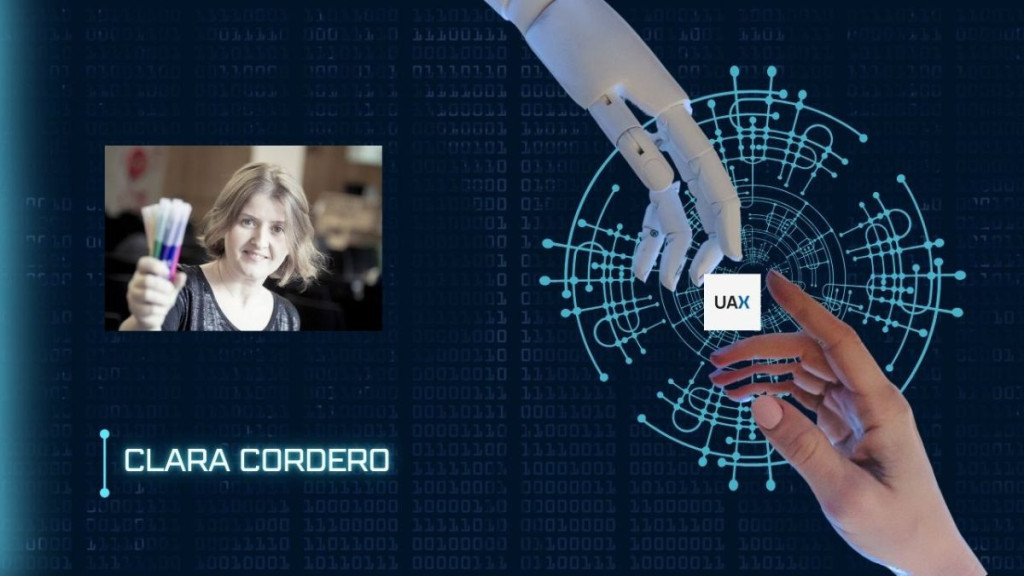Interview Clara Cordero, professor in the Master of Educational Technology and Digital Teaching Competence at UAX
Clara is a professor of Design and Creation of Digital Educational Content and Gamification and Educational Video Games.
She is an educational consultant and teacher trainer in the fields of technology, digital competence, gamification, and active methodologies.
She designs learning experiences that involve proactivity, motivation, and where technology enhances the process to achieve greater immersion.
As a trainer of trainers in the Master’s program in Educational Technology and Digital Competence, generally speaking,
How are teachers when they are on the student side? I believe that everyone dedicated to education has two sides: teacher and student. A teacher never stops learning, either because they want to stay updated or because they learn from their own students.
It’s not always easy to empathize with the student’s perspective, but if you are committed to learning, you will identify those needs because you also feel them. Therefore, teachers are also students, and we try to address not only the cognitive side of the experience but also the experiential and emotional aspects, covering needs that go beyond the content itself and into the daily life of the student.
AI has arrived to stay, even in the public sector, as long as we use it correctly.
How can a student benefit from AI on a daily basis? AI is a technology at the service of humans. Its greatest potential lies in its efficiency. Students should inform and train themselves in the use of this technology to become competent and benefit from it.
AI can facilitate many processes of searching and gathering information because it handles much more information than we can. In any case, it will always be the student who must confirm whether the response is accurate, useful, and meets their needs.
What tools or platforms do you recommend to help a student? What makes AI special is that it has reached the user level without needing to know coding or programming, but there are still some platforms that require a steeper learning curve.
It will depend on the student’s needs and their digital competence, but broadly speaking, AI can be very useful for synthesizing information and making summaries or paraphrasing, as with Quillbot, for making information more accessible by including formats like audio, as with Speechify, or generally, at a conversational level for obtaining information, like ChatGPT. Additionally, you can benefit from its various bots to tailor the requested instruction.
An example is Ursula, a bot created by Juanjo del Haro to improve educational prompts.
On July 17th, you developed a webinar on How to Use AI to Pass Teaching Exams.
Do you consider there is a correct use of AI when preparing for exams? We cannot talk about correct or incorrect use of AI in general terms because it depends on the person using it, their principles and values, and their digital competence in interacting with it.
First, I like to contextualize the use of AI with its potential fakes, biases, and the need for academic responsibility so it doesn’t become a plagiarism tool.
From there, the different prompts used to get the most benefit and efficiency from responses will be each person’s responsibility. I tend to provide references because I emphasize the importance of creative questioning to solve different problems, which is usually challenging. The key is to ask good questions, and AI has highlighted that it’s not as easy as it seems.
New technologies always face challenges, some of which are ethics and privacy.
What issues should be considered when using AI tools in education? Ethics and privacy are at the core of using these tools. Until now, we had somewhat lost the battle with these, either because everything on the internet and social media spreads quickly or because of the lack of transparency of platforms. With AI, we have a new opportunity to regain data protection by being efficient and ethical in sharing information and reviewing and highlighting the lack of transparency of various tools and platforms. I think it’s time to be proactive and assertive, which has led to new legislation on AI use, such as the prohibition of obtaining biometric data or, in the case of social networks, the notification that you can refuse to have your data used to train AI.
For students, I emphasize being careful with what they upload and extending that protection to make them aware that some platforms are creating their own secure cloud spaces for users, always at an organizational level and always under their privacy policies.
